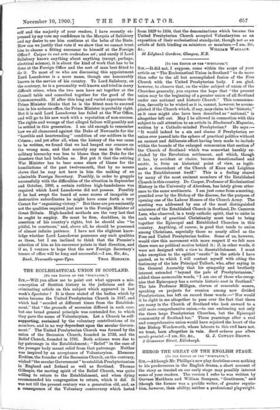THE ECCLESIASTICAL UNION IN SCOTLAND.
[TO THE EDITOR OF THE "SPECTATOR."]
SIR, Will you allow me to point out what appears a mis- conception of Scottish history in the judicious and dis- criminating article on this subject which appeared in last week's Spectator ? It is there stated of the bodies which by union became the United Presbyterian Church in 1847, and which had " seceded at different times from the Establish- ment," that " the grounds of secession differed in each case, but one broad general principle was contended for, to which they gave the name of Voluntaryism. Let a Church be self- supporting, sustained by the voluntary contributions of its members, and in no way dependent upon the secular Govern- ment." The United Presbyterian Church was formed by the union of the Secession Church, founded in 1733, and the Relief Church, founded in 1761. Both schisms were due to lay patronage in the Establishment ; " Relief " in the case of the younger body meant relief from that patronage. Neither was inspired by an acceptance of Voluntaryism. Ebenezer Erskine, the founder of the Secession Church, on the contrary, wished "the secular Government " to establish Presbyterianism in England and Ireland as well as Scotland. Thomas Gillespie, the moving spirit of the Relief Church, was quite willing to return to the Establishment, and when dying recommended his congregation to return, which it did. It was not till the present century was a generation old, and, as a consequence of the Voluntary controversy which lasted
from 1829 to 1834, that the denominations which became the United Presbyterian Church accepted Voluntaryism as an exposition of their ecclesiastical standpoint, though not as an article of faith binding on ministers or members.—I am, Sir,






































 Previous page
Previous page